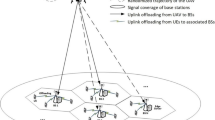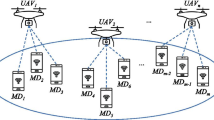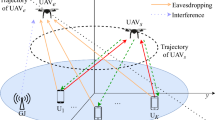Abstract
Unmanned aerial vehicles (UAVs) have become an inevitable choice due to their advantages of flexible movement and rapid deployment for ensuring emergency communication services. The endurance of UAVs may be limited due to the inability to charge in time in emergency communication scenarios. In this paper, we present a non-orthogonal multiple access (NOMA) based multi-UAV dispatching mobile edge computing (MEC) offloading for emergency communication networks, where each UAV is equipped with MEC server to provide computing services for terrestrial users, and NOMA technology is used to increase spectrum utilization and reduce task processing energy consumption. The main goal is to maximize the energy efficiency of UAV-MEC systems by jointly optimizing computing resources, power control, and UAV dispatch in this paper. The system energy efficiency (SEE) optimization problem is complex and non-convex, to solve this, we first adopt the Dinkelbach method to transform the original problem into an equivalent problem. Then, we decompose the equivalent problem into a resource allocation subproblem based on a given UAV dispatching strategy and UAV dispatching subproblem for a given resource allocation strategy. To address the resource allocation problem, we derive closed-form solutions for computing resources and power allocation with the Lagrangian dual method. Next, we propose a three-stage UAV energy-efficient dispatching scheme based on the global K-Means (GKM) algorithm to optimize the dispatching of UAVs. Numerical results demonstrate the effectiveness of the proposed scheme.









Similar content being viewed by others
Data Availability
The datasets generated and analyzed during the current study are not publicly available due to their containing information that could compromise the privacy of research participants but are available from the corresponding author on reasonable request.
References
Ada, S., Sharman, R., Han, W., & Brennan, J. A. (2016). Factors impacting the intention to use emergency notification services in campus emergencies: an empirical investigation. IEEE Transactions on Professional Communication, 59(2), 89–109. https://doi.org/10.1109/TPC.2016.2527248
Lei, C., Lin, W., & Miao, L. (2015). A stochastic emergency vehicle redeployment model for an effective response to traffic incidents. IEEE Transactions on Intelligent Transportation Systems, 16(2), 898–909. https://doi.org/10.1109/TITS.2014.2345480
Zhou, J., Jia, J. Y., Zhang, Z., & Chen, S. W. (2020). Key technologies for emergency communication based on 5G networked UAVs. Journal of Chongqing University of Posts and Telecommunications (Natural Science Edition), 32(4), 511–518.
Dong, C., Shen, Y., & Qu, Y. B. (2020). A survey of UAV-based edge intelligent computing. Chinese Journal of Intelligent Science and Technology, 2(3), 227–239.
Liu, Y., Qin, Z., Cai, Y., Gao, Y., Li, G. Y., & Nallanathan, A. (2019). UAV communications based on non-orthogonal multiple access. IEEE Wireless Communications, 26(1), 52–57. https://doi.org/10.1109/MWC.2018.1800196
Senadhira, N., Durrani, S., Zhou, X., Yang, N., & Ding, M. (2020). Uplink NOMA for cellular-connected UAV: impact of UAV trajectories and altitude. IEEE Transactions on Communications, 68(8), 5242–5258. https://doi.org/10.1109/TCOMM.2020.2995373
Feng, W., et al. (2020). NOMA-based UAV-aided networks for emergency communications. China Communications, 17(11), 54–66. https://doi.org/10.23919/JCC.2020.11.005
Mei, W., & Zhang, R. (2019). Uplink cooperative NOMA for cellular-connected UAV. IEEE Journal of Selected Topics in Signal Processing, 13(3), 644–656. https://doi.org/10.1109/JSTSP.2019.2899208
Ji, J., Zhu, K., Yi, C., & Niyato, D. (2021). Energy consumption minimization in UAV-assisted mobile-edge computing systems: joint resource allocation and trajectory design. IEEE Internet of Things Journal, 8(10), 8570–8584. https://doi.org/10.1109/JIOT.2020.3046788
Liu, M., Yang, J., & Gui, G. (2019). DSF-NOMA: UAV-assisted emergency communication technology in a heterogeneous internet of things. IEEE Internet of Things Journal, 6(3), 5508–5519. https://doi.org/10.1109/JIOT.2019.2903165
Wang, Z. D., Zhang, T. K., Xu, W. J., & Yang, L. W. (2020). Dynamic Caching Placement and Resource Allocation in UAV Emergency Communication Networks. Journal of Beijing University of Posts and Telecommunications, 43(6), 42–50. https://doi.org/10.13190/j.jbupt
Zhou, F., Wu, Y., Hu, R. Q., & Qian, Y. (2018). Computation rate maximization in UAV-enabled wireless-powered mobile-edge computing systems. IEEE Journal on Selected Areas in Communications, 36(9), 1927–1941. https://doi.org/10.1109/JSAC.2018.2864426
Hu, X., Wong, K., Yang, K., & Zheng, Z. (2019). UAV-assisted relaying and edge computing: scheduling and trajectory optimization. IEEE Transactions on Wireless Communications, 18(10), 4738–4752. https://doi.org/10.1109/TWC.2019.2928539
Dang, T., Liu, C., & Peng, M. (2022). Low-latency mobile virtual reality content delivery for unmanned aerial vehicle-enabled wireless networks with energy constraints. IEEE Transactions on Vehicular Technology. https://doi.org/10.1109/TVT.2022.3212868
Liao, N., He, P., Zhang, Y., et al. (2022). Trajectory and resource allocation optimization method for UAV-relaying communication. Mobile Communications, 46(S9), 1–7.
Tang, R., Feng, W., Chen, Y., & Ge, N. (2021). NOMA-based UAV communications for maritime coverage enhancement. China Communications, 18(4), 230–243. https://doi.org/10.23919/JCC.2021.04.017
Dai, M., Wu, Y., Qian, L., Su, Z., Lin, B., & Chen, N. (2022). UAV-assisted multi-access computation offloading via hybrid NOMA and FDMA in marine networks. IEEE Transactions on Network Science and Engineering. https://doi.org/10.1109/TNSE.2022.3205303
Li, G. Q., Lin, J. Z., Xu, Y. J., Huang, Z. W., & Liu, T. (2020). User grouping and power allocation algorithm for UAV-aided NOMA network. Journal on Communications, 41(9), 21–28.
Zhou, X., Huang, L., Ye, T., & Sun, W. (2022). Computation bits maximization in UAV-assisted MEC networks with fairness constraint. IEEE Internet of Things Journal, 9(21), 20997–21009. https://doi.org/10.1109/JIOT.2022.3177658
He, Y., Gan, Y., Cui, H., & Guizani, M. (2023). Fairness-based 3-D multi-UAV trajectory optimization in multi-UAV-assisted MEC system. IEEE Internet of Things Journal, 10(13), 11383–11395. https://doi.org/10.1109/JIOT.2023.3241087
Wang, W., Ni, W., Tian, H., & Song, L. (2022). Intelligent Omni-surface enhanced aerial secure offloading. IEEE Transactions on Vehicular Technology, 71(5), 5007–5022. https://doi.org/10.1109/TVT.2022.3150769
Budhiraja, I., Kumar, N., Tyagi, S., & Tanwar, S. (2021). energy consumption minimization scheme for NOMA-based mobile edge computation networks underlaying UAV. IEEE Systems Journal, 15(4), 5724–5733. https://doi.org/10.1109/JSYST.2021.3076782
Zhang, X., Zhang, J., Xiong, J., et al. (2020). Energy efficient multi-UAV-enabled multi-access edge computing incorporating NOMA. IEEE Internet of Things Journal, 7(4), 5613–5627.
Wang, Y., Ru, Z.-Y., Wang, K., & Huang, P.-Q. (2020). Joint deployment and task scheduling optimization for large-scale mobile users in multi-UAV-enabled mobile edge computing. IEEE Transactions on Cybernetics, 50(9), 3984–3997. https://doi.org/10.1109/TCYB.2019.2935466
Mozaffari, M., Saad, W., Bennis, M., & Debbah, M. (2017). Mobile unmanned aerial vehicles (UAVs) for energy-efficient internet of things communications. IEEE Transactions on Wireless Communications, 16(11), 7574–7589. https://doi.org/10.1109/TWC.2017.2751045
Ruan, L., et al. (2018). Energy-efficient multi-UAV coverage deployment in UAV networks: A game-theoretic framework. China Communications, 15(10), 194–209. https://doi.org/10.1109/CC.2018.8485481
Alzenad, M., El-Keyi, A., & Yanikomeroglu, H. (2018). 3-D placement of an unmanned aerial vehicle base station for maximum coverage of users with different QoS requirements. IEEE Wireless Communications Letters, 7(1), 38–41. https://doi.org/10.1109/LWC.2017.2752161
Qin, J., Wei, Z., Qiu, C., & Feng, Z. (2019). Edge-prior placement algorithm for UAV-mounted base stations. IEEE Wireless Communications and Networking Conference (WCNC), 2019, 1–6. https://doi.org/10.1109/WCNC.2019.8885992
Nouri, N., Abouei, J., Sepasian, A. R., Jaseemuddin, M., Anpalagan, A., & Plataniotis, K. N. (2022). Three-dimensional multi-UAV placement and resource allocation for energy-efficient IoT communication. IEEE Internet of Things Journal, 9(3), 2134–2152. https://doi.org/10.1109/JIOT.2021.3091166
Al-Hourani, A., Kandeepan, S., & Lardner, S. (2014). Optimal LAP altitude for maximum coverage. IEEE Wireless Communications Letters, 3(6), 569–572. https://doi.org/10.1109/LWC.2014.2342736
Dorling, K., Heinrichs, J., Messier, G. G., & Magierowski, S. (2017). ‘Vehicle routing problems for drone delivery. IEEE Transactions on Systems, Man, and Cybernetics: Systems, 47(1), 70–85.
Islam, S. M. R., Avazov, N., Dobre, O. A., & Kwak, K. (2017). Power-domain non-orthogonal multiple access (NOMA) in 5G systems: potentials and challenges. IEEE Communications Surveys & Tutorials, 19(2), 721–742. https://doi.org/10.1109/COMST.2016.2621116
Zhou, F., & Hu, R. Q. (2020). Computation efficiency maximization in wireless-powered mobile edge computing networks. IEEE Transactions on Wireless Communications, 19(5), 3170–3184. https://doi.org/10.1109/TWC.2020.2970920
Dinkelbach, W. (1967). On nonlinear fractional programming. Management Science, 13, 492–498.
Zhang, X., Zhang, J., Xiong, J., Zhou, L., & Wei, J. (2020). Energy-efficient multi-UAV-enabled multiaccess edge computing incorporating NOMA. IEEE Internet of Things Journal, 7(6), 5613–5627. https://doi.org/10.1109/JIOT.2020.2980035
Xiao, Z., Liu, H., Havyarimana, V., Li, T., & Wang, D. (2016). Analytical study on multi-tier 5G heterogeneous small cell networks: Coverage performance and energy efficiency. Sensors, 16(11), 1854.
Muñoz, O., Pascual-Iserte, A., & Vidal, J. (2013). Joint allocation of radio and computational resources in wireless application offloading. Future Network & Mobile Summit, 2013, 1–10.
Acknowledgements
This work is supported by the Natural Science Foundation of Gansu Province, China (No. 20JR10RA182). This work is supported by the Gansu Provincial Key R&D Program-Industrial Project under Grant No. 23YFGA0062.
Author information
Authors and Affiliations
Contributions
All authors contributed to the study conception and design. Material preparation, data collection and analysis were performed by Xiangrui Guan and Jianbin Xue. The first draft of the manuscript was written by Xiangrui Guan and all authors commented on previous versions of the manuscript. All authors read and approved the final manuscript.
Corresponding author
Ethics declarations
Competing interests
The authors declare that they have no known competing financial interests or personal relationships that could have appeared to influence the work reported in this paper.
Additional information
Publisher's Note
Springer Nature remains neutral with regard to jurisdictional claims in published maps and institutional affiliations.
Appendices
Appendix 1: The Derivation of Eq. (4)
From (3), for \(m = 1\), we obtain
For \(m = 2\), we have
by analogy, for \(m = M_{u}\), we have
Expand \(O_{u} [k] = \sum\limits_{m = 1}^{{M_{u} }} {O_{mu} [k]}\), we can obtain
Substitute (46), (47), and (48) into (49), we have
According to the properties of logarithmic functions, the total throughput of users to UAV u at the kth time slot can be expressed as
The Eq. (4) is achieved.
Appendix 2: Prove Lemma 1
For \(\min \left\{ {\tau B\log_{2} \left( {1 + \sum\limits_{m = 1}^{{M_{u} }} {\frac{{p_{mu} [k]g_{mu} [k]}}{{\sigma^{2} }}} } \right),\sum\limits_{m = 1}^{{M_{u} }} {\frac{{\tau f_{mu} [k]}}{{C_{u} }}} } \right\}\), there are three cases:
-
(i)
\(\tau B\log_{2} \left( {1 + \sum\limits_{m = 1}^{{M_{u} }} {\frac{{p_{mu} [k]g_{mu} [k]}}{{\sigma^{2} }}} } \right) > \sum\limits_{m = 1}^{{M_{u} }} {\frac{{\tau f_{mu} [k]}}{{C_{u} }}} ;\)
-
(ii)
\(\tau B\log_{2} \left( {1 + \sum\limits_{m = 1}^{{M_{u} }} {\frac{{p_{mu} [k]g_{mu} [k]}}{{\sigma^{2} }}} } \right) < \sum\limits_{m = 1}^{{M_{u} }} {\frac{{\tau f_{mu} [k]}}{{C_{u} }}} ;\)
-
(iii)
\(\tau B\log_{2} \left( {1 + \sum\limits_{m = 1}^{{M_{u} }} {\frac{{p_{mu} [k]g_{mu} [k]}}{{\sigma^{2} }}} } \right) = \sum\limits_{m = 1}^{{M_{u} }} {\frac{{\tau f_{mu} [k]}}{{C_{u} }}} .\)
Next, we would use contradiction analysis to prove that (iii) holds. We assume that there is another set of solutions besides the optimal solution. Let \(\Lambda\) be the objective function of problem P3-2, then we can define the corresponding objective functions for the solution \(\{ p_{mu} [k]^{*} ,f_{mu} [k]^{*} \}\) and \(\{ p_{mu} [k]]^{\prime},f_{mu} [k]^{\prime}\}\) as \(\Lambda^{*}\) and \(\Lambda^{\prime}\), respectively. Suppose (i) holds, and \(f_{mu} [k]^{*} = f_{mu} [k]{\prime}\), \(p_{mu} [k]^{*} \ge p_{mu} [k]{\prime}\), and \(\sum\nolimits_{u = 1}^{{\widehat{U}}} {\sum\nolimits_{m = 1}^{{M_{u} }} {p_{mu} [k]^{*} } } > \sum\nolimits_{u = 1}^{{\widehat{U}}} {\sum\nolimits_{m = 1}^{{M_{u} }} {p_{mu} [k]{\prime} } }\). Obviously, the objective function \(\Lambda\) decreases with \(p_{mu} [k]\) increasing, thus we have \(\Lambda^{*} < \Lambda^{\prime}\), the case (i) is not satisfied.
Similarly, suppose (ii) holds, and \(p_{mu} [k]^{*} = p_{mu} [k]{\prime}\), \(f_{mu} [k]^{*} \ge f_{mu} [k]{\prime}\). It is obvious that the objective function decreases with increasing, thus we have \(\Lambda^{*} < \Lambda{\prime}\), the case (ii) is not satisfied.
Based on the above analysis, case (iii) holds, and Lemma 1 is proved.
Rights and permissions
Springer Nature or its licensor (e.g. a society or other partner) holds exclusive rights to this article under a publishing agreement with the author(s) or other rightsholder(s); author self-archiving of the accepted manuscript version of this article is solely governed by the terms of such publishing agreement and applicable law.
About this article
Cite this article
Guan, X., Xue, J. Energy-Efficient Computing Offloading Based on Multi-UAV Dispatch via NOMA in Emergency Communication Networks. Wireless Pers Commun 133, 199–226 (2023). https://doi.org/10.1007/s11277-023-10764-y
Accepted:
Published:
Issue Date:
DOI: https://doi.org/10.1007/s11277-023-10764-y




